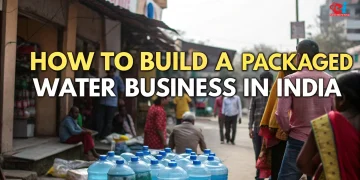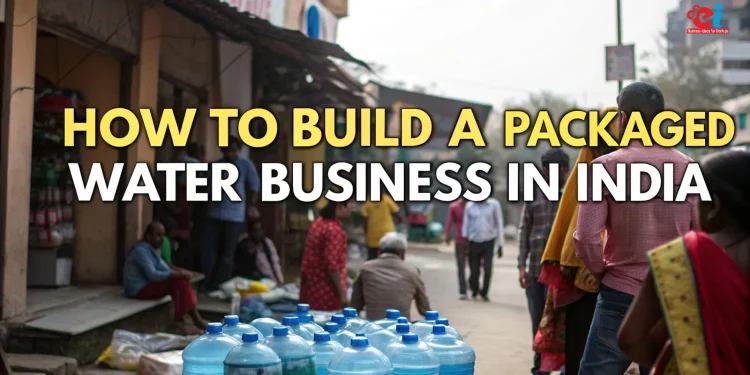In the past two decades, India’s Packaged Water Business sector has become one of the most lucrative business opportunities in the world. Bottled water is no longer a luxury. With the growing awareness of consumers about their health and rapid urbanization as well as concerns about safe drinking water, it has become a necessity. The demand for bottled water is consistent, whether in metro areas or remote towns. This makes it a recession-resistant, attractive business.
This guide provides a comprehensive blueprint to launch a packaged-water plant in India. It covers market potential, compliance, operational setup and production, branding, as well as strategies for profitability.
The Industry Overview: A Booming Essential
In India, Packaged Water Business is water that has been purified and treated before being sealed into containers for human consumption. This sector is different from natural mineral waters, which are bottled and sourced with minimal processing.
The industry can meet the diverse needs of consumers — from small PET bottles designed for travellers to bulk jars used in offices and homes, as well as premium glass bottles used by the hospitality sector. Demand is constant throughout the year, even though summer is when sales are at their peak.
Packaged Water Business has become a staple of Indian consumers’ daily lives due to the shift towards convenience and hygiene. This has created a market that is both robust and growing for regional and national brands.
Related: How to Start a Packaged Water Business
Market demand, growth, and future outlook
In India, the Packaged Water Business market has grown by double digits over the past ten years. The growing middle class in India, rising incomes and better distribution networks have made bottled water more accessible to semi-urban and rural areas.
By 2023, it is expected to reach Rs 245 billion. According to projections, the market could reach Rs500 billion in 2028 if it maintains a growth rate of 14-15% per year.
Demand is driven by several factors
- Rapid urban population increase and migration to cities without reliable tap water supply.
- Tourism is a major factor in the growth of bottled water sales, especially in hotels and tourist destinations.
- Demand for large quantities of office and commercial supplies.
- Consumers prefer branded and sealed drinking water to local alternatives.
In the future, niche products will be developed to cater to health-conscious consumers. These include alkaline waters, water infused with vitamins, and eco-friendly packaging.

Get Licensed: Compliance with Regulatory Standards
In order to maintain product safety and the trust of consumers, it is necessary to adhere to strict regulations when starting packaged Water Business in India. The primary certification comes from the Bureau of Indian Standards, under IS 14543. This mandates specific testing and packaging standards, as well as treatment processes.
To operate in the food and beverages sector, you must have a Food Safety and Standards Authority of India licence. A license is required to operate in the food and beverage industry.
To maintain a license, it is mandatory to conduct regular water quality tests. Compliance is a continuous responsibility. Failure to meet standards could result in plant closures, heavy fines or loss of reputation.
Selecting the Right Product Blend
Profitability is not solely dependent on the volume of sales, but also on selecting the right range of products. Retail sales of PET bottles in the 500 ml or 1-litre size account for a significant share, particularly in urban and semiurban markets. The bulk 20-litre jars are a reliable source of revenue for offices, households, and institutions.
Hotels and restaurants with a high level of service use premium glass bottles, which are often sold at a substantial discount. In rural markets, where cost is a major factor, religious festivals and public gatherings, smaller pouches and packets are very popular. Spreading risk across a balanced product portfolio maximizes reach and spreads the risk.
Related: The Future of Bottled Water Manufacturing: A Step-by-Step Guide for First-Time Entrepreneurs
Set up the plant: Infrastructure and location strategy
Location of your Packaged Water Business has an impact on both the production costs and the market reach. It should be located near a source of clean, abundant, water to reduce procurement costs and close to target markets to lower distribution expenses.
The facility must include zones for storage of raw water, filtration, bottling and packaging, as well as warehousing. It is essential to have separate quality control labs for each stage of production. A good road network ensures that goods are delivered on time to retailers, distributors and bulk buyers.
An efficient layout not only meets hygienic and compliance standards, but also streamlines the workflow to reduce operational delays.
The Manufacturing process: From source to seal
To ensure consistency, purity and safety, there are several steps involved in the production of packaged drinking waters.
The first step is to source raw water, either from a borehole, municipal line or a natural source. The pre-treatment process removes impurities visible through sedimentation and the sand filter. Then, activated carbon filters eliminate chlorine, organic matter and pesticide traces.
Membranes for reverse osmosis (RO), which remove heavy metals and chemical contaminants, are dissolved salts. The next step is UV sterilization which kills bacteria and viruses, followed by ozonation, which provides long-term protection against microbial contamination during storage.
Re-mineralization is necessary because RO filtration removes beneficial minerals. This step improves the taste and nutritional value of water by restoring essential elements such as calcium and magnesium. Automated machinery is used to bottle, cap, label, and shrink wrap the treated water. Each batch is subjected to stringent quality tests before it’s sent out for sale.
Build a Profitable Packaged Water Business
New entrants in a market dominated largely by big names like Bisleri Kinley and Aquafina must differentiate themselves. All marketing efforts should focus on quality assurance, backed up by certification marks.
Packaging can play a major role in brand recognition. Attractive labels, ergonomic bottle forms, and tamper proof seals are all factors that influence purchasing decisions. Localized branding can be achieved by aligning your brand with local events, partnering up with local retailers and sponsoring social causes.
Some regional brands that have been successful in the past have used niche positioning to build a loyal following, for example, eco-friendly bottles and mineral blends that promote health.
View our Handbooks for more information
Distribution and Sales Strategy
In order to make a packaged-water plant profitable, distribution is a key factor. A successful model often includes direct delivery to important accounts, such as hotels and restaurants, with wider retail coverage via distributors.
Purchasing in bulk from institutions can bring in a predictable and steady income. Seasonal promotions can also boost sales, especially during the summer peak months. Online ordering and delivery via apps are becoming more popular, as they allow brands to directly reach their customers.
Sustainable Practices for Long-Term Growth
Sustainability is a key differentiator for the industry, especially with growing environmental concerns. Many manufacturers are switching to recyclable PET bottles. They also run awareness campaigns about bottle returns and explore biodegradable packaging.
Water recycling systems inside the plant and efficient production processes reduce waste. Brands who adopt eco-conscious practices not only improve their image, but also may benefit from government policies and incentives.
Overcoming Common Challenges
While the industry offers attractive returns to entrepreneurs, they must also be prepared for certain challenges. Price wars can be a result of high competition, especially in the mass market segment. Transport costs can be high due to the weight and volume of water products. Inventory and cash management are critical for managing seasonal demand fluctuations.
Every deviation from the standards can damage a brand’s reputation. For sustained profitability, it is important to build resilience through diversified product lines, efficient operations and strong distributor relationships.
For more information, check out this video
How NPCS can help you launch successfully
NIIR Project Consultancy Services provides expert advice to entrepreneurs who are looking for a low-risk and high-efficiency way to enter the packaged drinking water industry. NPCS provides Market Study cum Detailed Techno-Economic Feasibility reports, which include detailed manufacturing processes, raw materials requirements, plant layouts, and financial projections. NPCS has decades of experience in the industry and can assist entrepreneurs to evaluate the feasibility of establishing new industries or expanding current ones .
Find the Best Idea for Yourself With our Startup Selector Tool
Conclusion
When approached with the correct mix of quality control and efficient production, along with strong branding and effective distribution, launching a packaged-water plant in India could be a highly profitable venture. Market growth and shifting consumer preferences are driving a robust market, creating numerous opportunities for innovation.
Entrepreneurs who are committed to sustainability, compliance and customer trust have the best chance at building a long-lasting business in this highly competitive but rewarding sector. You can turn a promising business idea into a thriving packaged-water enterprise with the help of NPCS and other consultancy firms.


















